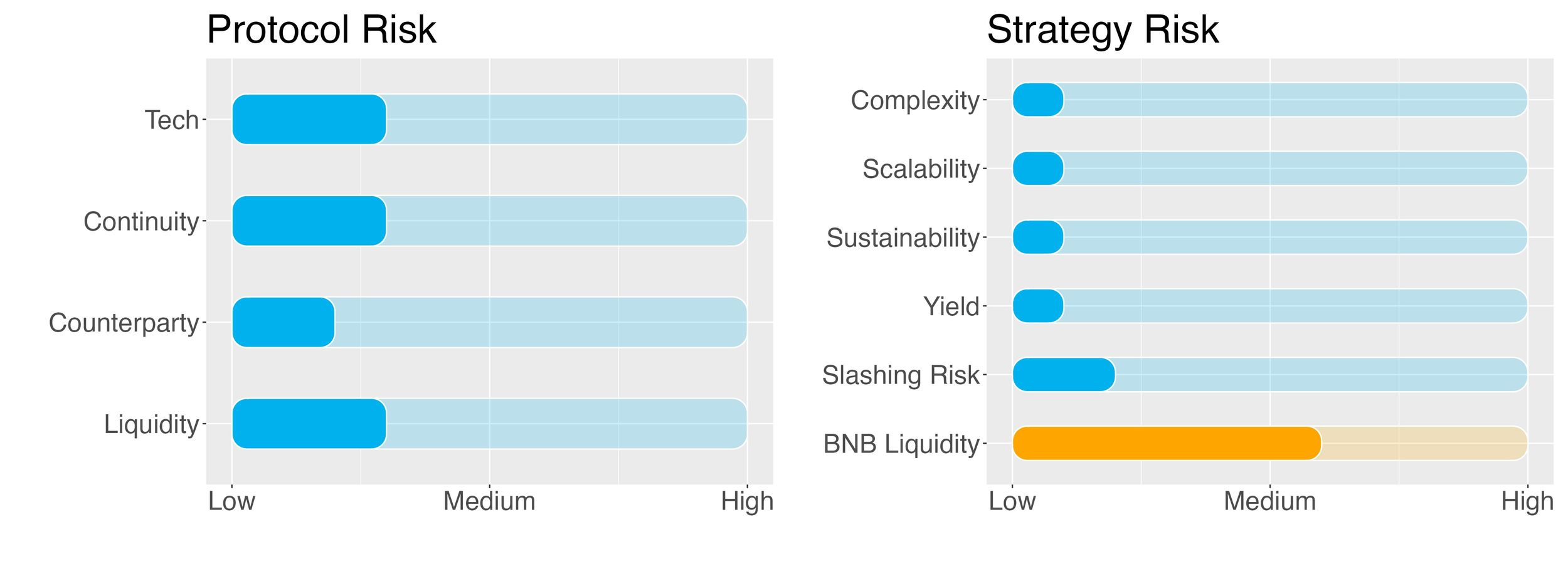Liquid staking on Stader

Key Takeaways:
- Liquid staking represents one of the safest options in DeFi to generate yield. The yield is further improved by farming the liquid staking tokens. Obviously, this additional yield comes with some additional risk.
- Stader is considered a secure and trustable liquid staking protocol.
- The yield (APY) is derived from BNB staking – contributing to the Proof-of-Stake consensus mechanism plus the farming of liquid staking tokens by depositing them in a BNB liquidity pool.
- Launched on 01 September 2020, the Binance Smart Chain (BSC) attempted to be a solution to the network congestion issues and high fees that plagued the Ethereum blockchain. BSC can handle smart contracts and be used to build dApps (decentralized applications) and enjoy really fast speeds and low transaction fees while being programmable. BSC transactions are validated using the Proof-of-Stake consensus algorithm via BNB staking.
- BNB liquid staking represents a mid term liquidity yield-generating investment. A lockup period of 90 days applies to this yield strategy and funds can be redeemed only at the end of this period.
- Risk Checklist In our view the predominant risks for this strategy are as follows:
- Counterparty risk
- Sustainability risk
- Liquidity risk of staking
1. Strategy Explained
The strategy involves liquid staking BNB tokens in Stader.
Pre-Subscription Period: 3 days.
Lockup period: 90 days.
2. Strategy Risks
Trust Score
Stader Labs is a non-custodial innovative contract-based staking platform that helps users conveniently discover and access staking solutions.
The protocol went live in December 2021 and displays a TVL of around $125m.
SwissBorg trust score for Stader is ‘green’, i.e. the protocol is trustable. The score value is 70% signaling that the protocol is reliable.
Protocol Risks
Project Continuity Risk
Project continuity risk is medium to low.
Stader displays a TVL $125m. This puts it in the top 10 staking protocols. The difference with the largest staking protocol, Lido, is however abysmal with Lido having over $9b locked in.
To assess the sentiment around Stader we look at its token price and volatility, as well as at the Google Trend for the last 30 and 90 days. Overall sentiment is medium.
Stader continuity risk is set to 3/10.
Counterparty Risk
Counterparty risk is deemed low.
Counterparty risk exists whenever an asset is handed over to an external provider. Any credit events involving the staking provider could affect the assets that have been entrusted to them.
That said, staking via a 3rd party is fundamentally different from depositing funds into a lending protocol that later becomes insolvent.
We seek to select only trustable staking providers in order to minimise counterparty risk.
Stader places utmost importance to ensure users' funds are staked with the best-in-class validators in the ecosystem. In order to be considered for Stader pools, validators need to meet threshold performance criteria (e.g. on up-time).
Each pool has a unique characteristic based on which validators are selected for that particular pool. In the long run Stader would select the validators programmatically and rebalance delegations based on performance filters. Additionally, as the Stader platform is decentralized, governance will determine validator selection criteria, policies, and so on.
Last, a Slashing Insurance will be provided by validators via the Stader tokens staked.
Counterparty risk is 2/10.
Liquidity Risk
Liquidity risk is deemed low.
Funds held by the staking provider are redeemable after the lockup period of 90 days.
Liquidity risk is 3/10.
Strategy Risks
Complexity
Complexity of strategy is low.
The strategy involves depositing BNB on Stader to perform staking.
Therefore one chain (BSC), 1 token and 1 protocol is required.
Complexity of the strategy is 1/10.
Scalability
Scalability risk of strategy is low.
Staking is a highly scalable practice. Indeed, the more stakers are participating, the higher the safety of the blockchain.
Scalability risk of the strategy is 1/10.
Sustainability
Sustainability risk of strategy is low.
The yield obtained from this strategy is fully sustainable as it comes from participating in the validation of BNB transactions, the Proof-of-Stake mechanism.
Proof-of-Stake is quite energy efficient when compared to Proof-of-Work chains like Bitcoin and has therefore practically no negative impact on the environment.
Sustainability risk of the strategy is 1/10.
Yield Risk
Yield risk of strategy is low.
Staking provides a constant stream of income with low variability.
Yield risk of the strategy is 1/10.
Slashing Risk
Slashing risk on BSC is low.
In order to secure the network from malicious validators, BSC implements “slashing” logic to penalize validators for double-signing (a validator signs two blocks at the same time), instability, or any other negative behavior. To put it simply, slashing refers to the process of taking or “slashing” a fixed amount of a validator’s stake. Such a penalty helps to sustain order and makes validators behave themselves in a righteous manner.
When validating the BSC chain the only risk for delegators is the loss of rewards when their staked validator is slashed. Their staked BNB will not be impacted.
Slashing risk is 2/10.
Liquidity Risks of staking
Liquidity Risk on staking BNB is medium.
Liquid staking on Stader requires the investor to lock-up their BNB tokens for a period of 90 days. Regardless of the direction the market chooses during this time, your assets will be out of reach. This aspect needs to be carefully considered when entering this strategy.
Liquidity risk is therefore set to 6/10.
3. Conclusions
BNB staking comes with some risk.
Liquid staking per se is generally considered a very safe investment. Stader, the chosen liquid staking protocol, has been reviewed and approved by SwissBorg tech team.
BNB staking comes with a 90-day lock-up period. This means that redemptions are possible only at the end of the period. Liquidity is therefore not always available.
The SwissBorg Risk Team ranks BNB staking as a Satellite investment, one for an investor with a good understanding of DeFi and yielding, who is willing to take on some risk in exchange for a fair reward on BNB.
Try the SwissBorg Earn today!





